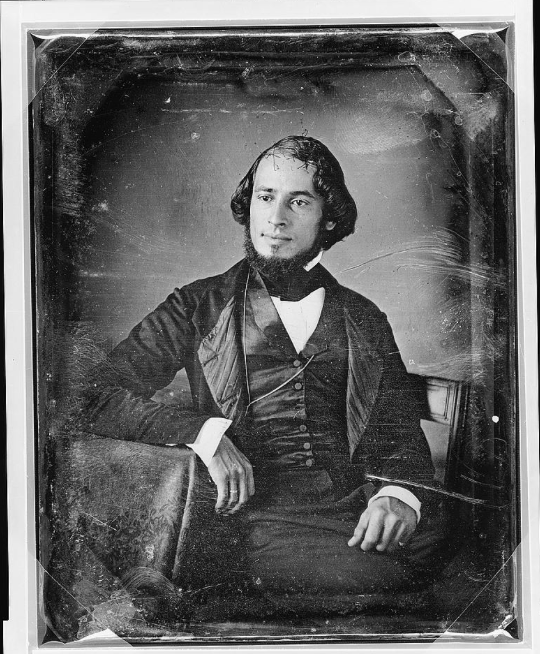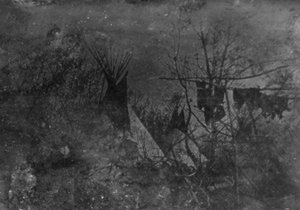- Home |
- About |
- Contact Us |
- RSS
Solomon Nunes Carvalho - Painter, Photographer, Author and Inventor
Artist who risked his life to document the American Northwest in the 1850s
Died: May 27th, 1897 - Pleasantville, New York
By Livia Sklar
Few of us will ever experience the life-threatening conditions that befell Solomon Nunes Carvalho in his role as artist with the last expedition of Col. John Fremont to the American Northwest in 1853. Indeed, had Carvalho fully understood the perils awaiting him, he might not have signed up to go. The 22-member expedition, which included ten Delaware Indian chiefs who acted as scouts, became bogged down in snow, one of its members perished, 27 of the horses and mules were eaten to stave off starvation (not by Carvalho, who didn't divulge his Jewish identity to members of the expedition but refrained from eating non-kosher animals), and Carvalho and his friend the topographer Egloffstein nearly died and had to be left in Utah to be nursed back to health by some kind Mormons. Carvalho documented the journey by keeping a secret diary (unknown to Fremont), and published his account in 1860 in a highly readable book entitled Incidents of Travel and Adventure in the Far West; with Colonel Fremont's Last Expedition. How did a Jewish boy from a prominent Sephardic family land up almost dying of starvation, scurvy and frostbite in the unexplored Rockies?

In Carvalho's own words, "On the 22d August, 1853, after a short interview with Col. J.C. Fremont, I accepted his invitation to accompany him as artist of an Exploring Expedition across the Rocky Mountains. A half hour previously, if anybody had suggested to me, the probability of my undertaking an overland journey to California, even over the emigrant route, I should have replied there were no inducements sufficiently powerful to have tempted me. Yet, in this instance, I impulsively, without even a consultation with my family, passed my word to join an exploring party, under command of Col. Fremont, over a hitherto untrodden country, in an elevated region, with the full expectation of being exposed to all the inclemencies of an arctic winter."
Carvalho's task on the expedition (which Fremont launched to prove the feasibility of a transcontinental railroad near the Thirty-Eighth Parallel) was to make daguerreotypes--the forerunners of photos--to document the journey. A daguerreotype image is made by sensitizing a silver surface with iodine and then exposing it to mercury vapor. As Carvalho notes in his account, his colleagues were skeptical about the project because "Buffing and coating plates, and mercurializing them, on the summit of the Rocky Mountains, standing at times up to one's middle in snow, with no covering above save the arched vault of heaven, seemed to our city friends one of the impossibilities--knowing as they did that iodine will not give out its fumes except at a temperature of 70 degrees to 80 degrees Fahrenheit." Nevertheless, Carvalho writes he was able to do so based on his "firm determination to succeed [which] produced results which, to my knowledge, have never been accomplished under similar circumstances." Unfortunately, most of the 300 daguerreotypes which Carvalho made nearly daily of expedition members, the native Americans they encountered and the landscape, were ultimately lost in a fire, and what remained were given by Fremont to another artist who mixed it in with his own work.
Carvalho's eye-witness account of Fremont's last expedition is full of first-hand vignettes (many not without humor), which document the perils of traveling to the western United States just before the Civil War. He describes hostile Indians, greedy expedition members, dangerous travel conditions, beautiful but treacherous landscapes, unexpected kindness, arduous hunts, and heroic leadership--all with clarity and candor.
After several weeks of recovering in Utah from the illnesses incurred during the Fremont expedition, "supping with" and painting portraits of Brigham Young, and taking detailed notes of the curious Mormon lifestyle which he later added to his book--Carvalho continued to California in order to complete his illustrations of Fremont's route and return by ship to New York City. Always interested in the Jewish community, Carvalho helped the 30 Jews living in Los Angeles at the time purchase land for a cemetery and form their own Hebrew Benevolent Society. He had deep Jewish roots.

Solomon Nunes Carvalho was born to a prominent Sephardic Jewish family in 1815 in Charleston South Carolina. (His parents had been born in England to Jewish families of Portuguese descent whose ancestors had fled the persecution in Portugal.) Solomon's uncle Emanuel Nunes Carvalho served as a cantor and rabbi in Barbados, Charleston and Philadelphia. Solomon married Sarah Solis (also from a prominent Sephardic Jewish family) in Philadelphia in 1845, and after a few years they moved to live with his family in Baltimore, with their son David and daughter Charity. Carvalho served on the board of the Philadelphia Hebrew Education Society, and with his wife helped found Baltimore's Beth Israel Sephardic Synagogue and the Baltimore Hebrew English Sunday School.
It was in his father's workshop in Baltimore that the young Carvalho became interested in portrait photography using the daguerreotype method. He also grew to be an excellent artist and one of his paintings at age 25 "Child with Rabbits" was used on national bank notes of several state banks. Col. Fremont had heard about Carvalho's expertise in daguerreotype photography and was in the process of outfitting his fifth expedition when he approached Carvalho to help "obtain an exact description of the face of the country" over which the expedition was to travel.
Carvalho could not continue functioning as an artist later in life due to cataracts (which would ultimately blind him.) However his creative abilities and interest in science led him to invent devices for steam superheating, the two patents for which won him a Medal of Excellence from the American Institute of NY. Carvalho died in 1897 in Pleasantville, NY and is buried in the Beth Olom cemetery in Ridgewood, Queens, NY.
- Carvalho's book has become the main source of information about Fremont's last expedition, since Fremont himself never wrote the extensive book he at one time envisioned about all his explorations of the West.
Some of these sites were used as source material for this entry and may be of interest to those looking to learn more about this person/topic.
- Incidents of Travel and Adventure in the Far West; with Colonel Fremont's Last Expedition, by S. N. Carvalho. New York, 1860
- Wikipedia - Solomon Nunes Carvalho
- Introduction to the U. of Nebraska Press edition of Carvalho's book by Ava F. Kahn, visiting scholar at U. of California, Berkeley
- Carvalho's Journey - A documentary film by Steve Rivo
SEE ALSO
 Copy the text below to cite your paper or article:
Copy the text below to cite your paper or article: 

